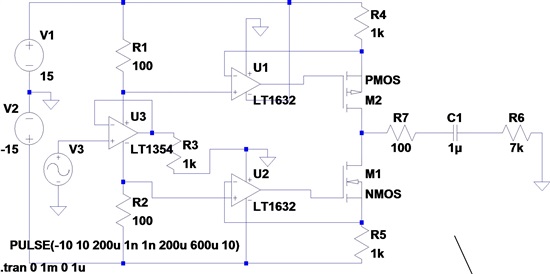Dear all,
I'm trying to build a bipolar constant current source to drive capacitive loads and I really hope you guys can help me out!
My requirements:
- the load is a micro-electrode, which can be modelled by a grounded C-R circuit (R~7k and C ranging from 10n to 3uF in series). As said, the load is grounded and capactively dominated.
- Vin is a rectangular bipolar pulse (f~25-200Hz with a pulse width of ~200us), which should be converted into a bipolar current pulse with amplitudes from 1-10mA.
Not-so-well working ideas:
- Improved Howland current pumps (using OPA404). Worked quite nice but only for small loads (10n-1uF) and low amplitudes (up to max. 1.5mA). If I exceed these, the current pulse breaks down or gets smoothed (not rectangular any more).
-Differential voltage to current converter (as specified in INA114 datasheet - Fig.13; the second OPA was also a OPA404). Works great for resistive loads but not for capacitive ones.
- using the XTR300. Well, in principle is has the same archtitecture as the diff. VCC as described above with the same limitations.
So am I doing something terribly wrong and one of these ideas should work or is there a better way to build something like this up? Using a transistor current source maybe?
Thank you very much for your ideas and time!
Kind regards,
Tim


